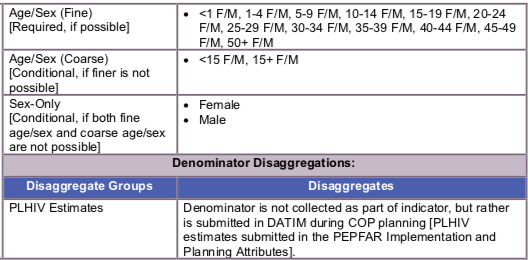(VL_SUPPRESSION_NAT) Percentage of people living with HIV who have suppressed viral loads at the end of the reporting period
Export Indicator
Viral suppression is the third and last 90 of the global target, and the ultimate goal of the HIV treatment cascade. Patients on ART who achieve and maintain viral suppression minimize their risk of disease progression and HIV transmission. Viral suppression is a critical quality of service quality; unsuppressed viral load can be indicative of suboptimal treatment adherence and can lead to the development and spread of drug resistance.
This indicator is harmonized with GAM indicator “People living with HIV who have suppressed viral loads.”
Number of people living with HIV and on ART [in the reporting period] who have a suppressed viral load (<1000 copies/mL)
Number of people living with HIV (PLHIV Estimate)
How to collect:
The numerator can be generated by counting the number of adults and children receiving antiretroviral therapy who have a suppressed viral load at the end of the reporting period. Count the patient if, during the reporting months, viral load has been recorded and is <1000 copies/mL. For countries with other thresholds (e.g., undetectable <50 copies/ml or <400 copies/ml), preliminary evidence from several studies suggests the proportion of those with 50 copies/ml or above and less than 1000 copies/ml is small, so no adjustment is required. The testing threshold value should be reported in the narrative for countries with thresholds other than <1000 copies/ml.
Viral-load testing should be routine rather than targeted (e.g., when treatment failure is suspected). If multiple viral-load tests are done annually for a person, only the last routine test result should be reported. Results from targeted viral loads should not be reported. If viral-load testing coverage is less than 75% of those receiving antiretroviral therapy in the reporting year, results should be interpreted with caution.
Tools for measuring viral load may vary across countries. Routine viral-load suppression tests from clinical and program data should be reported where available. In countries where such data are not available, results from HIV population-based surveys or drug-resistance surveys based on a random sample of people on antiretroviral therapy may be reported. Countries should report the source of the numerator and denominator data, and data from both sources should be reported if available, although clinical and program data are preferred. If results from a survey are used, that should be included when reporting.
Where clinical and program data are available from routine monitoring systems, results will be recorded in patient files or in a laboratory system. Data should be de-duplicated where patients receive multiple viral-load tests in a year.
If an HIV population-based or drug-resistance survey is used in place of routine program monitoring data, measurement of viral load should be done for the entire population of HIV- positive individuals where ARV is detected in specimens. Self-reported treatment status has been shown to be of limited quality. Therefore, viral-load estimates among those who report receiving antiretroviral therapy should not be used.
Reporting level: National and Sub-national: Data should be entered for all SNUs, regardless of PEPFAR- funded support for these geographical areas; so that the total of the sub-national number should equal the total number of national number.
Reporting frequency: Annually
![]()

Indicator changes (MER 2.0 v2.3 to v2.4): None
Data entered by: This data should be entered in DATIM by the USG country team.
Guiding narrative questions:
- Describe the data systems and methods of aggregation used at the national and subnational levels to report treatment data.
- Outline any work that the host country government has done to ensure that the reported figures are accurate (i.e., data quality assessments, results adjustment, etc.).
- Discuss progress towards aligning host-country age/sex disaggregations to standard five-year age and sex bands?
- For targets, please describe the host country target setting process.